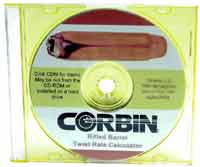
|
| ||
| Home Page | Current Prices | Free Docs |

|
| All Software | Paper Patch Designer | Swage Dies | |
|
The program instantly changes all figures from metric to English or vice versa, at the click of a button. You can convert meters per second to feet per second, grams per cubic centimeter to pounds per cubic inch. A pop-up calculator window converts various density and specific gravity values for you, and provides a list of media, core, jacket and tip materials with their density. Clicking one of these values, and then clicking "calculate" displays the value in gm/cc, lb/cubic inch, SG, and other equivalents. Clicking a button for core, jacket, tip, or media transfers the density you have selected back to the main program window and inserts it into the selected component entry box for you. You can save all the figures in a file by clicking a button, and print either the saved info as a report, or print the window just as it appears without saving any data. You can also enter data and then save it as the new defaults, so that you can customize the program to remember and recall your own figures instead of its original defaults. |
| DC-TWIST can be run from the CD-ROM (without saving reports or defaults) or installed on your hard drive, using the self-starting menu on the CD-ROM. Just put the CD-ROM in your drive, and the menu will appear (if your system has been set to allow auto-start: otherwise, click CDM for CD Menu). No technical expertise is required to calculate the proper twist rate for any bullet! At the price, any bullet maker should have this useful tool in their arsenal. |
|
The program adjusts the spin rate required for very low and very high velocities, since the rate of spin generates different centrifugal forces on the bullet as the velocity changes. Once the bullet is free of the barrel, the velocity has little effect on required spin, but since velocity determines the bullet rotational speed imparted by the rifling twist, a higher twist rate would be required to stabilize a bullet fired at very low speed compared to firing the same bullet at a high speed. This is a neglected factor in conventional Greenhill calculations. Obviously, at zero forward velocity there is no rotation imparted, and at very low forward velocity, the same numbers of turns per unit of distance generates a very small number of revolutions per minute, but the usual method of calculating stable twist has no input factor for varying velocity.
Likewise, a bullet with the center of gravity shifted far to the rear will require much higher spin rate to maintain nose-forward attitude compared to a bullet with the CG shifted further forward. Most bullets have their center of gravity somewhat aft of the linear midpoint. If dropped from a height with the nose pointed down, they would land base first. A nose-heavy bullet, on the other hand, would land nose first. In flight it would require less spin to maintain nose-forward attitude. With the CG moved too far forward, the bullet would require little or no spin to strike nose first, but would follow the launch attitude over its trajectory path (that is, the nose would continue to point in the direction and angle at which it left the barrel, so that as the trajectory arc became larger with greater distances, the bullet would tend to fly at an angle to the direction its nose pointed, and would begin to tumble). DC-TWIST considers the location of the bullet center of gravity, so that with all other parameters equal, a bullet with the weight shifted forward, such as a hollow base wadcutter, an airgun pellet, or a hollow base shotgun slug, would require less spin than a bullet having a long pointed nose and a flat solid base. Likewise, bullets composed of different density materials, such as tungsten powder base sections and plastic nose fillers, would require different spin rates than the same weight and size of bullet with the same average density in a monolythic core design. The program allows for location of the CG relative to the center of form, as a percentage from the base to the tip. Entering a value more than zero and less than 100 lets the engineer shift the balance of the bullet and determine the effect on stable spin rate. |
| Home | Presses | Intro | Site Map | P.R. | Chemicals | Answers |

|
| Prices | Specials | How To | Bullets | B.Makers | Books | Classified | |
| Topics | Jackets | Terms | Training | Software | Products | Contact us |
 The DC-TWIST program helps you calculate the proper spin rate (rifling twist) for any bullet, as well as the RPM of the bullet at any velocity. Unlike the conventional Greenhill formula, Corbin's twist rate calculator factors in differences in jacket, core, and tip density in English or Metric units, as well as velocity and center of gravity, and allows change of media through which the bullet travels. You can calculate stable twist rates for firing at different air densities, through gasses, under water, etc.
The DC-TWIST program helps you calculate the proper spin rate (rifling twist) for any bullet, as well as the RPM of the bullet at any velocity. Unlike the conventional Greenhill formula, Corbin's twist rate calculator factors in differences in jacket, core, and tip density in English or Metric units, as well as velocity and center of gravity, and allows change of media through which the bullet travels. You can calculate stable twist rates for firing at different air densities, through gasses, under water, etc.